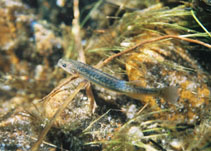| Diagnosis: |
Dorsal spines (total): 0-0; Dorsal soft rays (total): 9-13; Anal spines: 0-0; Anal soft rays: 9-14; Vertebrae: 36-42. Diagnosis: body slender and cylindrical, without scales; dorsal fin placed far back over anal fin; caudal fin truncated; mouth terminal, jaws with teeth; large eyes; internal organs visible in live specimens (Ref. 52193). Loss of two laterosensory pores beneath the lower jaw; elongate caudal peduncle (Ref. 93822).
Description: snout rounded, as long as or little shorter than eye (Ref. 2989, 54167). Body depth 4.6-7.0x and head length 3.5-5.0x TL (Ref. 2989, 54167, 93595, 93596, 93785). Dorsal fin insertion 59,3-67,0% of SL; length of caudal peduncle is 17,8-23,1% of SL (Ref. 93822). Eye of moderate size, set high and well forward in head; interorbital more or less flat (Ref. 93822). Teeth on jaws subequal (Ref. 54167, 93596, 93785), delicate, pointy and uniserial (Ref. 6461, 93595). Teeth on entopterygoid short, pointy and uniserial (Ref. 6461, 93595) and on tongue margin large and recurved in double row (Ref. 6461). No distinct enlarged canines (Ref. 93785, 93822). Jaws equal anteriorly (Ref. 2989, 54167, 93785). Maxillary extending to below anterior border (Ref. 2989) or anterior fourth of eye (Ref. 2989, 54167, 93785). Lower jaw may slightly project (Ref. 54167, 93596). Dorsal-fin: 9-11 (Ref. 93822), 10-12 (Ref. 2989, 54167, 93596, 93785) or 11-13 (Ref. 5214, 6461, 52193) rays. Dorsal fin well forward in SL; distal margin rounded (Ref. 93822). Anal fin: 9-12 (Ref. 93785), 9-13 (Ref. 93822), 10-12 (Ref. 2989, 54167, 93596) or 11-14 (Ref. 5214, 6461, 52193, 54167). Anal fin distal margin rounded (Ref. 93822). Pelvic fin: 6 (Ref. 2989, 54167, 93595, 93785, 93822) to 7 (Ref. 93595, 93822) rays. Pelvic fins inserted at midpoint of SL; pelvic-anal interval quite short; fins small (Ref. 93822). Pectoral fin: 14-17 rays; short and fan shaped (Ref. 93822). Pelvic fins: 6-7 rays (Ref. 93822). Caudal fin: 13-15 rays; long; peduncle flanges low but extending well along peduncle towards bases of dorsal and anal fins (Ref. 93822). Gill rakers short (Ref. 2989, 54167, 93822). On upper limb 2-3 (Ref. 6461) and on lower limb 9-10 (Ref. 6461) or 8 (Ref. 2989, 54167, 93785) gill rakers. Vertebrae: 39-41 (Ref. 6461) or 36-42 (Ref. 93822).
Coloration: semi-transparent, due to complete absence of scales; degree of pigmentation largely affected by general colour of stream or lake bottom (Ref. 93591, 93592). Body with or without darker blotches or bars on sides and back (Ref. 52193). Belly lighter (Ref. 1904, 54167). Vertebrae, red gills, heart and silvery lining of body cavity showing through (Ref. 5214, 6461, 52193, 93591). Adults males usually darker in colour than females (Ref. 93592). |
| Biology: |
May penetrate some distance inland and is widespread in lakes and rivers (Ref. 3563), which may be either acid (pH 5-6,5) or alkaline (pH 8-9) (Ref. 93592, 93822). Prefers gentle currents within shelter of banks near the head of pools (Ref. 3563, 52193). Small but extremely hardy, they are known to tolerate a wide range of water and temperature conditions (Ref. 5214, 6164, 52193, 93591, 93592). Feeds on small drifting invertebrates (Ref. 7248, 52193). Spawning period occurs in spring up to middle of summer (Ref. 5214, 33843, 52193), depending on the conditions (Ref. 52193). Ripe eggs are demersal, relatively large and numbering about 30-40 (Ref. 93592). Their small size and cryptic color enable them to avoid predators (Ref. 52193). |

